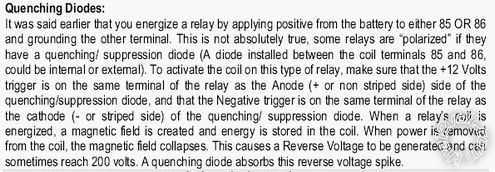Posted: February 05, 2010 at 7:55 AM / IP Logged
Posted: February 07, 2010 at 11:42 PM / IP Logged
Posted: February 08, 2010 at 1:51 AM / IP Logged
Posted: February 08, 2010 at 2:39 AM / IP Logged
Posted: February 08, 2010 at 2:52 AM / IP Logged
Posted: February 08, 2010 at 3:28 AM / IP Logged
Posted: February 08, 2010 at 3:44 AM / IP Logged
Posted: February 08, 2010 at 3:58 AM / IP Logged
Posted: February 08, 2010 at 4:47 AM / IP Logged
Posted: February 08, 2010 at 5:10 AM / IP Logged
 Printable version
Printable version


| You cannot post new topics in this forum You cannot reply to topics in this forum You cannot delete your posts in this forum You cannot edit your posts in this forum You cannot create polls in this forum You cannot vote in polls in this forum |

| Search the12volt.com |
Follow the12volt.com 
Tuesday, January 13, 2026 • Copyright © 1999-2026 the12volt.com, All Rights Reserved • Privacy Policy & Use of Cookies


Tuesday, January 13, 2026 • Copyright © 1999-2026 the12volt.com, All Rights Reserved • Privacy Policy & Use of Cookies
Disclaimer:
*All information on this site ( the12volt.com ) is provided "as is" without any warranty of any kind, either expressed or implied, including but not limited to fitness for a particular use. Any user assumes the entire risk as to the accuracy and use of this information. Please
verify all wire colors and diagrams before applying any information.








 DO NOT FOLLOW THE ADVICE IN THE ABOVE IMAGE
I originally included something like the above in my last reply, but later deleted it after I thought I got it wrong!
But I am right... amn't I... [For quenching - Kathode/line towards +ve (#86); anode to gnd/negative (#85)]
DO NOT FOLLOW THE ADVICE IN THE ABOVE IMAGE
I originally included something like the above in my last reply, but later deleted it after I thought I got it wrong!
But I am right... amn't I... [For quenching - Kathode/line towards +ve (#86); anode to gnd/negative (#85)]
 ? ....or
? ....or  &
& ?
I think I'm right - never trust expert forums.
Except this one.
And Howie.
BTW - I was thinking the 1A diode was enough for the quenching.
[And yes, it should be 400V; 200V can be a bit low. Besides, the IN4004 400V/1A is now generally "the common" lowest rated diode - ie, lesser rated power diodes cost more!]
But it is also fine in series with any "normal" relay - even the oversized 100A relay with its 8W = ~0.7A solenoid/coil.
I'm even thinking of buying a bulk pack of 1N4004 (a few dollar$ for 100) and throwing out those unlabelled 50V 1A I got years ago for 2c each - 50V "unpolarised" cleanskins just ain't worth it!)
Rem: Hail Howie!!
?
I think I'm right - never trust expert forums.
Except this one.
And Howie.
BTW - I was thinking the 1A diode was enough for the quenching.
[And yes, it should be 400V; 200V can be a bit low. Besides, the IN4004 400V/1A is now generally "the common" lowest rated diode - ie, lesser rated power diodes cost more!]
But it is also fine in series with any "normal" relay - even the oversized 100A relay with its 8W = ~0.7A solenoid/coil.
I'm even thinking of buying a bulk pack of 1N4004 (a few dollar$ for 100) and throwing out those unlabelled 50V 1A I got years ago for 2c each - 50V "unpolarised" cleanskins just ain't worth it!)
Rem: Hail Howie!!